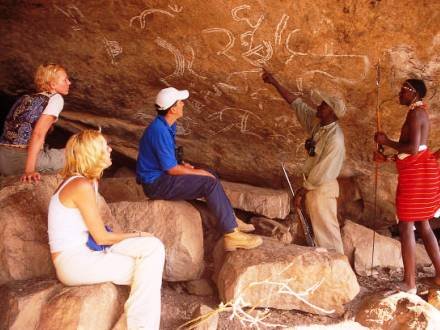 Kenya is a country that offers an incredible blend of cultural experiences for travelers looking to explore its deep-rooted heritage. Swedish tourists in particular will find the nation’s diversity of ethnic traditions, historical landmarks, and preserved villages especially enriching. Whether you are drawn to the coastal cities or the highland communities, Kenya provides many ways to immerse yourself in its vibrant past and living traditions. One of the most compelling cultural draws is along Kenya’s Indian Ocean coast. In Mombasa, Fort Jesus stands as a formidable reminder of the Portuguese colonial presence. Built in the 16th century, the fort has witnessed centuries of conquest and trade. A short distance away, the Old Town of Lamu offers an entirely different experience. Recognized as a UNESCO World Heritage Site, Lamu is one of the oldest and best-preserved Swahili settlements in East Africa. Its narrow streets, coral stone houses, and intricately carved doors transport visitors to a bygone era of trade, Islamic learning, and artistic expression. For those who want a direct connection with Kenya’s living traditions, several cultural villages and centers provide meaningful interactions. The Bomas of Kenya in Nairobi showcases architectural replicas of homes from various ethnic groups, along with performances of music and dance. Outside the capital, the Maasai Cultural Villages near Amboseli and the Samburu villages in the north give tourists the chance to meet pastoralist communities who proudly maintain their customs. Engaging with these groups allows Swedish tourists to understand traditional practices and hear oral stories that have been passed down through generations. Another layer of Kenya’s culture can be explored through its sacred sites and national monuments. Near Kisumu, Kit Mikayi is a towering rock formation that holds spiritual significance for the Luo people. Locals believe it represents a mythical woman who still watches over the community. In Nairobi, Uhuru Gardens commemorates Kenya’s independence from British rule. Visitors can stroll through the open grounds, view symbolic sculptures, and reflect on the nation’s journey to self-determination. The best Kenyan cultural sites for Swedish tourists offer a unique window into the country’s multifaceted identity. Each destination opens up an opportunity to better understand Kenya's deep traditions, resilience, and communal values. Whether you are wandering through the alleys of a centuries-old coastal city or sitting around a fire in a traditional village, the cultural connections are both profound and personal. Kenya’s strength lies in its diversity. The more than 40 ethnic communities spread across different landscapes have maintained customs that date back hundreds of years. For Swedish tourists, these encounters are not only informative but emotionally resonant, offering new perspectives on storytelling, spirituality, art, and architecture. The rhythm of tribal music, the symbolism in traditional beadwork, and the folklore passed down through generations all provide insight into how Kenyans live, celebrate, and remember. These cultural sites are not mere relics or tourist attractions; they are living, breathing embodiments of Kenya’s past and present. Whether at the foot of the sacred Kit Mikayi rocks or in the shadows of Fort Jesus, visitors are invited to participate in the narrative. The hospitality of the Kenyan people further enriches these experiences, making the journey not only educational but deeply welcoming. Kenya's cultural tapestry is both vast and inviting, drawing visitors into a world where tradition and modernity intersect. For Swedish travelers seeking authenticity, these sites offer more than just stories they offer lasting memories and human connection.
Kenya is a country that offers an incredible blend of cultural experiences for travelers looking to explore its deep-rooted heritage. Swedish tourists in particular will find the nation’s diversity of ethnic traditions, historical landmarks, and preserved villages especially enriching. Whether you are drawn to the coastal cities or the highland communities, Kenya provides many ways to immerse yourself in its vibrant past and living traditions. One of the most compelling cultural draws is along Kenya’s Indian Ocean coast. In Mombasa, Fort Jesus stands as a formidable reminder of the Portuguese colonial presence. Built in the 16th century, the fort has witnessed centuries of conquest and trade. A short distance away, the Old Town of Lamu offers an entirely different experience. Recognized as a UNESCO World Heritage Site, Lamu is one of the oldest and best-preserved Swahili settlements in East Africa. Its narrow streets, coral stone houses, and intricately carved doors transport visitors to a bygone era of trade, Islamic learning, and artistic expression. For those who want a direct connection with Kenya’s living traditions, several cultural villages and centers provide meaningful interactions. The Bomas of Kenya in Nairobi showcases architectural replicas of homes from various ethnic groups, along with performances of music and dance. Outside the capital, the Maasai Cultural Villages near Amboseli and the Samburu villages in the north give tourists the chance to meet pastoralist communities who proudly maintain their customs. Engaging with these groups allows Swedish tourists to understand traditional practices and hear oral stories that have been passed down through generations. Another layer of Kenya’s culture can be explored through its sacred sites and national monuments. Near Kisumu, Kit Mikayi is a towering rock formation that holds spiritual significance for the Luo people. Locals believe it represents a mythical woman who still watches over the community. In Nairobi, Uhuru Gardens commemorates Kenya’s independence from British rule. Visitors can stroll through the open grounds, view symbolic sculptures, and reflect on the nation’s journey to self-determination. The best Kenyan cultural sites for Swedish tourists offer a unique window into the country’s multifaceted identity. Each destination opens up an opportunity to better understand Kenya's deep traditions, resilience, and communal values. Whether you are wandering through the alleys of a centuries-old coastal city or sitting around a fire in a traditional village, the cultural connections are both profound and personal. Kenya’s strength lies in its diversity. The more than 40 ethnic communities spread across different landscapes have maintained customs that date back hundreds of years. For Swedish tourists, these encounters are not only informative but emotionally resonant, offering new perspectives on storytelling, spirituality, art, and architecture. The rhythm of tribal music, the symbolism in traditional beadwork, and the folklore passed down through generations all provide insight into how Kenyans live, celebrate, and remember. These cultural sites are not mere relics or tourist attractions; they are living, breathing embodiments of Kenya’s past and present. Whether at the foot of the sacred Kit Mikayi rocks or in the shadows of Fort Jesus, visitors are invited to participate in the narrative. The hospitality of the Kenyan people further enriches these experiences, making the journey not only educational but deeply welcoming. Kenya's cultural tapestry is both vast and inviting, drawing visitors into a world where tradition and modernity intersect. For Swedish travelers seeking authenticity, these sites offer more than just stories they offer lasting memories and human connection.
Top-Rated Kenyan Heritage Sites for Swedish Travelers
| Cultural Site | Location | Highlight |
|---|---|---|
| Fort Jesus | Mombasa | 16th-century Portuguese fort |
| Lamu Old Town | Lamu Island | Swahili architecture and traditions |
| Bomas of Kenya | Nairobi | Traditional homesteads and performances |
| Maasai Cultural Village | Near Amboseli | Live cultural experience with the Maasai |
| Kit Mikayi | Near Kisumu | Sacred rock formation of the Luo people |
| Uhuru Gardens | Nairobi | Symbol of Kenya's independence |
Discover Kenya's Historic Forts and Ancient Coastal Cities
The coastal region of Kenya offers a captivating journey through centuries of trade, migration, conquest, and cultural fusion. For Swedish tourists with an interest in rich historical narratives and well-preserved heritage, the Swahili coast presents an unforgettable exploration of East Africa's past. The story begins in Mombasa, home to Fort Jesus an iconic 16th-century fort built by the Portuguese to protect their interests along the Indian Ocean. Its thick walls, strategic design, and layered history reveal centuries of military and commercial significance. Today, it stands as a UNESCO World Heritage Site and museum, drawing thousands of international visitors annually. Just north of Mombasa lies the historic town of Malindi, another center of early maritime trade. Here, visitors can discover ancient ruins, old mosques, and tombs that echo Kenya’s Islamic and Arab influences. Farther north, the island town of Lamu provides a deeper immersion into Swahili heritage. Recognized by UNESCO, Lamu Old Town is one of the oldest and best-preserved Swahili settlements in East Africa. Its narrow alleyways, coral stone houses, and ornately carved wooden doors offer a unique glimpse into a society that balanced trade, spirituality, and art for centuries. Walking through these towns, one can almost hear the voices of traders, scholars, and artisans who once made this coast a vibrant cultural hub. Swedish tourists will find that the architecture, cuisine, language, and even the rhythms of everyday life in these coastal towns reflect an enduring Swahili influence that continues to shape Kenya's national identity. The experience of discovering these coastal treasures is not just about looking at the past it is about understanding a living heritage that thrives to this day. This deep connection to a shared human story makes the coastal journey both educational and deeply personal. Coastal Kenya Swahili heritage for Swedish tourists is more than a travel theme; it is a pathway into discovering how global histories have intersected to form distinct, beautiful cultures that remain vibrant and resilient. Along the coastline, every structure, sound, and scent tells a layered story. From the rhythmic call to prayer echoing from centuries-old mosques to the vibrant marketplaces filled with spices, textiles, and handcrafted ornaments, the Swahili coast pulses with life and legacy. For Swedish travelers, the immersion goes far beyond sightseeing. Local guides offer stories passed down through generations, recounting tales of Arabian traders, Portuguese colonizers, and African royalty whose lives intertwined along these shores. Culinary experiences are another highlight, where visitors can sample dishes influenced by Indian, Arab, and African flavors such as coconut rice, samosas, and grilled seafood infused with tangy tamarind. Cultural festivals also provide unforgettable encounters. Events like the Lamu Cultural Festival or the Mombasa Carnival offer a rich showcase of Swahili poetry, traditional dances, dhow sailing competitions, and artisanal crafts. These festivals not only entertain but also affirm the enduring cultural pride of local communities. Whether it's standing at the edge of the ocean beside the towering walls of Fort Jesus, navigating the winding alleys of Lamu on a donkey, or sipping spiced tea on a rooftop while listening to ocean breezes, the coast offers a cultural immersion unlike any other. For Swedish tourists, it is an emotional, sensory, and intellectual journey into one of Africa's richest living cultures.
What Are the Best Historic Forts and Coastal Sites in Kenya for Swedish Visitors?
Kenya's coastal region is a cultural mosaic where centuries of global influence meet African traditions. For Swedish visitors, exploring this historic corridor offers a deep dive into Swahili civilization, maritime history, and colonial legacies. The coast is not just scenic; it's a living museum filled with timeless architecture, legendary forts, and bustling towns where history still breathes. Here are some of the must-visit sites:
- Fort Jesus, Mombasa: This 16th-century Portuguese-built fort is one of Kenya's most visited historical landmarks. The fort's thick coral stone walls, underground passages, and exhibit halls provide insight into colonial military strategy and centuries of trade. Visitors can take guided tours and enjoy panoramic views of the Indian Ocean.
- Old Town Mombasa: Adjacent to Fort Jesus, Old Town is a Swahili-Arabic gem with narrow lanes, intricately carved doors, and antique balconies. Walking tours introduce Swedish tourists to centuries-old architecture and the multicultural spirit of this trading port.
- Lamu Old Town: A UNESCO World Heritage Site, Lamu is East Africa's oldest and best-preserved Swahili settlement. It features coral stone buildings, traditional dhow boats, and Islamic learning centers. Visitors can explore museums, mosques, and enjoy traditional Swahili hospitality.
- Gede Ruins: Near Malindi, the Gede Ruins are the remains of a 13th-century Swahili town hidden in a forest. The ruins include palace foundations, mosques, and tombs. Local guides share stories of its mysterious abandonment and the community that once thrived there.
These coastal landmarks provide Swedish tourists with authentic cultural insights and a memorable experience of Kenya's diverse and storied heritage. Each site offers a unique story, reflecting centuries of interaction between African, Arab, and European cultures. From architectural marvels to vibrant street life, these destinations leave visitors with a deeper appreciation for Kenya's enduring Swahili identity.
Explore Traditional Villages and Indigenous Cultural Centers
 Kenya's indigenous communities offer rich, immersive experiences for travelers looking to connect deeply with the country's living traditions. For Swedish tourists, the opportunity to interact with local communities in authentic settings allows for a genuine appreciation of Kenya's diverse cultures. These experiences go beyond sightseeing; they are cultural exchanges that promote understanding, respect, and shared humanity. The Bomas of Kenya in Nairobi serves as an excellent starting point for such exploration. This cultural center features life-sized replicas of traditional homesteads representing various ethnic groups, including the Kikuyu, Luhya, Kalenjin, and more. The center also hosts daily performances of traditional music and dance, each piece reflecting stories of everyday life, folklore, and spiritual beliefs. It offers visitors a curated but informative glimpse into the architecture, social structure, and rituals of Kenya's communities. Beyond the capital, the Maasai Cultural Villages near Amboseli National Park offer a more immersive encounter. Here, Swedish tourists can engage directly with the Maasai one of Kenya's most internationally recognized ethnic groups. Visitors are welcomed into traditional manyattas (mud-walled huts), learn about the community's pastoralist lifestyle, and observe traditional beadwork and ceremonies. These exchanges are conducted respectfully, often guided by elders who share personal and communal stories that have been passed down for generations. Another enriching destination is the Samburu villages in northern Kenya. The Samburu people share many cultural traits with the Maasai but have their distinct language, attire, and rituals. Travelers can join in traditional dances, witness cattle herding practices, and learn about the tribe's deep spiritual connection to nature and livestock. Exploring Maasai Mara traditions for Swedish travelers provides a powerful example of how cultural tourism can be both enlightening and impactful. In the Maasai Mara region, beyond the famed wildlife safaris, lies a vibrant community that continues to uphold its customs amid modernization. The people here offer more than just performances; they open up their homes and hearts to curious visitors. These experiences allow travelers not just to observe but to participate, fostering cross-cultural respect and awareness. Through these village visits and cultural encounters, Swedish tourists gain more than memories; they leave with stories, friendships, and a renewed appreciation for the diversity of the human experience. These experiences often become the most cherished part of their journey, far surpassing the value of photos or souvenirs. Sitting with village elders, listening to age-old myths, or watching a traditional dance performed under the open sky fosters a profound connection to Kenyan culture. Many travelers describe these moments as transformative, leaving with a new lens on the value of heritage and the meaning of community. Kenya’s indigenous communities serve as stewards of tradition, preserving practices that are increasingly rare in a rapidly modernizing world. Their willingness to share is both a gift and a bridge across continents and cultures. This hospitality reflects a broader Kenyan ethos that values kinship, storytelling, and hospitality. For Swedish tourists, who often come from societies where individualism is more pronounced, these communal ways of life can feel refreshingly grounding and inspiring. These cultural exchanges contribute positively to local economies, supporting community-led tourism initiatives that prioritize ethical and sustainable travel. Tourists not only learn but also contribute creating a relationship based on mutual benefit and respect. As a result, cultural tourism becomes a two-way learning journey: the visitor gains cultural insight while the host community gains recognition, empowerment, and resources to preserve its heritage. It is in these heartfelt human connections over shared meals, songs, and stories that Swedish travelers find the true magic of Kenya's cultural landscape. These simple yet profound moments often leave the deepest impressions. Whether gathered around a fire listening to oral histories or joining in celebratory dances under starlit skies, visitors discover an authentic side of Kenya that goes far beyond tourist attractions. These experiences resonate emotionally, reminding travelers of our shared humanity and the universal power of culture to connect and inspire across borders and backgrounds.
Kenya's indigenous communities offer rich, immersive experiences for travelers looking to connect deeply with the country's living traditions. For Swedish tourists, the opportunity to interact with local communities in authentic settings allows for a genuine appreciation of Kenya's diverse cultures. These experiences go beyond sightseeing; they are cultural exchanges that promote understanding, respect, and shared humanity. The Bomas of Kenya in Nairobi serves as an excellent starting point for such exploration. This cultural center features life-sized replicas of traditional homesteads representing various ethnic groups, including the Kikuyu, Luhya, Kalenjin, and more. The center also hosts daily performances of traditional music and dance, each piece reflecting stories of everyday life, folklore, and spiritual beliefs. It offers visitors a curated but informative glimpse into the architecture, social structure, and rituals of Kenya's communities. Beyond the capital, the Maasai Cultural Villages near Amboseli National Park offer a more immersive encounter. Here, Swedish tourists can engage directly with the Maasai one of Kenya's most internationally recognized ethnic groups. Visitors are welcomed into traditional manyattas (mud-walled huts), learn about the community's pastoralist lifestyle, and observe traditional beadwork and ceremonies. These exchanges are conducted respectfully, often guided by elders who share personal and communal stories that have been passed down for generations. Another enriching destination is the Samburu villages in northern Kenya. The Samburu people share many cultural traits with the Maasai but have their distinct language, attire, and rituals. Travelers can join in traditional dances, witness cattle herding practices, and learn about the tribe's deep spiritual connection to nature and livestock. Exploring Maasai Mara traditions for Swedish travelers provides a powerful example of how cultural tourism can be both enlightening and impactful. In the Maasai Mara region, beyond the famed wildlife safaris, lies a vibrant community that continues to uphold its customs amid modernization. The people here offer more than just performances; they open up their homes and hearts to curious visitors. These experiences allow travelers not just to observe but to participate, fostering cross-cultural respect and awareness. Through these village visits and cultural encounters, Swedish tourists gain more than memories; they leave with stories, friendships, and a renewed appreciation for the diversity of the human experience. These experiences often become the most cherished part of their journey, far surpassing the value of photos or souvenirs. Sitting with village elders, listening to age-old myths, or watching a traditional dance performed under the open sky fosters a profound connection to Kenyan culture. Many travelers describe these moments as transformative, leaving with a new lens on the value of heritage and the meaning of community. Kenya’s indigenous communities serve as stewards of tradition, preserving practices that are increasingly rare in a rapidly modernizing world. Their willingness to share is both a gift and a bridge across continents and cultures. This hospitality reflects a broader Kenyan ethos that values kinship, storytelling, and hospitality. For Swedish tourists, who often come from societies where individualism is more pronounced, these communal ways of life can feel refreshingly grounding and inspiring. These cultural exchanges contribute positively to local economies, supporting community-led tourism initiatives that prioritize ethical and sustainable travel. Tourists not only learn but also contribute creating a relationship based on mutual benefit and respect. As a result, cultural tourism becomes a two-way learning journey: the visitor gains cultural insight while the host community gains recognition, empowerment, and resources to preserve its heritage. It is in these heartfelt human connections over shared meals, songs, and stories that Swedish travelers find the true magic of Kenya's cultural landscape. These simple yet profound moments often leave the deepest impressions. Whether gathered around a fire listening to oral histories or joining in celebratory dances under starlit skies, visitors discover an authentic side of Kenya that goes far beyond tourist attractions. These experiences resonate emotionally, reminding travelers of our shared humanity and the universal power of culture to connect and inspire across borders and backgrounds.
Where Can Swedish Experience Authentic Kenyan Village Life Today?
For Swedish travelers eager to discover the heart of Kenya, authentic village life offers an unparalleled opportunity to connect with local culture in a meaningful way. Away from the bustling cities and wildlife safaris lies a network of communities that have preserved their traditional customs, values, and lifestyles through generations. Visiting these villages is not simply a cultural detour it's a deep dive into Kenya's soul. The journey often begins in Nairobi at the Bomas of Kenya, a cultural center that introduces visitors to Kenya’s major ethnic groups through life-sized homestead replicas, traditional dances, and live music. This introduction sets the stage for deeper exploration in rural areas, where traditions come alive in daily routines. For example, a visit to the Maasai Cultural Villages near Amboseli National Park immerses tourists in the practices of this iconic pastoralist community. Swedish visitors can witness bead-making, spear-throwing, and storytelling around a fire, gaining firsthand insight into a community where oral tradition, cattle herding, and spiritual belief remain central. In northern Kenya, the Samburu people invite tourists to engage in their rituals and ceremonies, offering a slightly different but equally rich experience. These exchanges are not staged performances but genuine expressions of daily life, made possible through mutual respect and trust between visitors and hosts. These immersive encounters are among the Kenyan cultural experiences loved by Swedish tourists. Many leave with a renewed perspective on simplicity, family bonds, and the spiritual connection between people and land. Village visits often include shared meals, communal dancing, and discussions with elders that illuminate worldviews far removed from Western norms. Such moments linger long after the trip ends, forming emotional touchpoints that enrich a traveler’s understanding of humanity. By participating in these respectful cultural exchanges, Swedish travelers not only learn but also help sustain heritage tourism, ensuring these living traditions continue to thrive. The impact of these visits extends beyond the moment. Local communities gain both economic support and recognition for their cultural knowledge, while tourists take away a more holistic view of the country. This mutual exchange strengthens the preservation of intangible cultural assets such as storytelling, craftsmanship, and traditional rituals. It encourages younger generations within these communities to value and continue their heritage. Swedish travelers return home not just with souvenirs, but with enriched perspectives and a greater appreciation for cultural diversity. As global tourism evolves, these types of meaningful interactions become increasingly valuable not just for entertainment, but for education, empathy, and sustainable development.
Visit Sacred Sites and Monuments Celebrating Kenyan Heritage
Kenya’s cultural journey is not complete without visiting its sacred sites and national monuments. These locations hold deep significance, representing Kenya’s spiritual beliefs, cultural evolution, and the struggle for independence. For Swedish travelers, exploring these heritage sites offers a reflective and powerful insight into the soul of the nation. From sacred stones rooted in myth to freedom monuments shaped by political history, these experiences go beyond sightseeing. One such destination is Kit Mikayi, a towering rock formation located near Kisumu in western Kenya. According to Luo legend, the rock represents the first wife of a polygamous man and is believed to hold spiritual energy. Pilgrims and tourists alike visit the site to meditate, pray, and learn about its revered status among the Luo people. The legend, passed down through generations, reflects the oral traditions that continue to shape Kenyan identity. In Nairobi, Uhuru Gardens is a key historical site that commemorates Kenya’s independence from British colonial rule in 1963. The garden houses a 24-meter high monument and symbolic sculptures representing unity and liberation. Walking through this space provides visitors with an opportunity to reflect on Kenya's political journey and celebrate its achievements as a sovereign nation. Beyond Kit Mikayi and Uhuru Gardens, Kenya has numerous smaller yet equally meaningful heritage spots, such as the Koobi Fora archaeological site near Lake Turkana, known as the "Cradle of Mankind." Swedish visitors with an interest in anthropology and early human history often find this destination enlightening. Kenya heritage tours popular among Swedish travelers offer more than just historical knowledge; they deliver emotional and spiritual depth. Each site tells a story, rooted in tradition or nationhood, that encourages visitors to look inward as much as outward. These places invite quiet contemplation, honor ancient ways of life, and affirm the importance of cultural continuity. They remind tourists that heritage is not simply preserved in museums but lives on in landscapes, legends, and landmarks. Whether standing before a sacred rock, listening to the echoes of a liberation speech, or exploring the early footprints of humankind, Swedish tourists find these sacred sites to be moments of pause and understanding. These locations are far more than tourist attractions; they are living markers of the Kenyan people's journey and evolution. By visiting these places, travelers step into stories of resilience, spirituality, and cultural pride that date back centuries. The powerful symbolism found at Kit Mikayi, for instance, allows visitors to connect with ancient beliefs and communal identity. Reflecting at Uhuru Gardens, where Kenya declared its independence, instills a sense of historical gravity and national unity. These sacred spaces are immersive and often emotional, serving as bridges between the past and present. The serenity and reverence they inspire allow Swedish tourists to slow down and absorb Kenya not just visually, but spiritually and intellectually. It is through these deeply personal encounters that travelers truly connect with the spirit of Kenya and leave with a profound appreciation of its cultural resilience, diversity, and unity. These moments linger long after the journey ends, becoming treasured memories that reinforce a broader understanding of Kenya's heritage and humanity.
Which Sacred Sites and Monuments Showcase Kenyan Heritage Best?
Kenya's sacred sites and historical monuments are essential to understanding the nation's identity and spiritual depth. For Swedish visitors, these sites offer a rare opportunity to witness the blend of mythology, religion, and historical resilience that defines Kenya's past and present. These cultural landmarks are not only visually striking but deeply rooted in stories passed down through generations. Kit Mikayi, near Kisumu, is one such place. This towering rock formation carries centuries of legend and spiritual symbolism for the Luo people. It is believed to represent a mythical woman and is used today as a site for prayer and meditation. Visitors can engage with local guides to understand the deeper meanings of its legend and why it remains a spiritual epicenter in the region. Uhuru Gardens in Nairobi is another important site. As the place where Kenya's independence was officially declared, it serves as a national symbol of freedom. Visitors can reflect upon Kenya's struggle for self-governance while exploring monuments that commemorate unity and resilience. Additional sites like the Koobi Fora archaeological area near Lake Turkana add a scientific and anthropological dimension to cultural tourism. Known as the "Cradle of Mankind," this site allows Swedish tourists to explore humanity's ancient roots through fossil evidence. Must-see cultural attractions in Kenya for Swedish visitors extend beyond nature and into these profound historical and sacred locations. These attractions are not only visually compelling but carry powerful narratives that reflect Kenya's identity and evolution. For those who wish to go beyond conventional sightseeing, such places provide meaningful engagement with Kenya's spiritual, historical, and cultural roots. Whether standing in awe beneath the sacred stones of Kit Mikayi or walking through the symbolic grounds of Uhuru Gardens, visitors experience more than just landmarks they feel the heartbeat of a nation. These sites often inspire reflection, curiosity, and emotional connection. Swedish travelers frequently describe their visits as transformative, citing how cultural insights gained from local stories, rituals, and monuments have shifted their understanding of Kenya and its people. The architectural beauty, symbolic sculptures, and oral histories attached to these places reveal the strength, struggles, and unity of Kenya through time. Such destinations foster a deep appreciation for Kenya’s resilience and diversity, making them invaluable stops for anyone wishing to grasp the nation’s true essence. They remind us that culture is not static; it thrives in the stories we tell, the spaces we protect, and the memories we share. For Swedish visitors, these experiences often become the emotional highlight of their trip.



